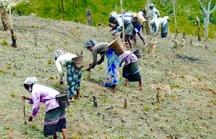Jhum
Jhum slash and burn technology of agriculture practiced mainly by the people of pre-plough age. Jhum is still practiced in chittagong hill tracts. Jhuming or shifting cultivation, popularly known as Sweden cultivation or cultivation of slash and burn, is the most prevalent form of cultivation in the hill areas of Bangladesh.
Most tribal people are well acquainted with this type of farming. Jhuming is practiced on sloppy hills outside reserve forests. At present, about 20,000 hectares of land are being brought under jhum cultivation every year, decaying 100 to 250 metric tons of soil per hectare of land.

The intensity of jhuming varies with changing conditions of rainfall, topography, accessibility, and density of population. On the basis of dependence, jhumia families are broadly classified into three categories: (i) primarily dependent, (ii) partially dependent, and (iii) marginally dependent. Methods adopted by tribal people in jhum cultivation vary from place to place and also among the category of farmers as jhuming forms an integral part of their life. In fact, the life and culture of the ethnic people of the Chittagong Hill Tracts depend to a great extent on jhum cultivation.
In jhuming, seeds are sown after the first rain in April. A broad blade knife, commonly known as dao, is used to sow the seeds. Small holes are made throughout the field by dao and a mixture of different crop seeds are placed in them. The main crops generally grown in jhum include rice, maize, millet, sesame, cucumber, pumpkin, melon, stringbean, cotton, banana, ginger, turmeric, etc. Very little weeding is carried out, except in some cases when it is considered necessary to provide protection against damages caused by wild animals and birds. Crops are harvested in succession as they ripe between July and December. Jhuming enhances soil erosion and depletes fertility. As a result, crop yields are low enough to sustain a Jhumia family in a limited area. The widely followed 7-8 years minimum rotation cycle has now been reduced to just 3-4 years but is still not sustainable.
In its original form, the fallow period was long enough to permit the growth of natural vegetation because of the availability of enough land for such cultivation. But in recent times, it has been dangerously reduced from its traditional ten year fallow period to two to three years. This is because of population pressure and the reduction of agricultural land due to the Kaptai reservoir and large-scale non-tribal settlements. Harmful results of jhum cultivation include reduction of soil fertility, erosion of land, deforestation, and siltation of rivers and lakes. As a result of all these, crop yields have decreased significantly. Thus it is very important to find out suitable alternatives to jhuming. [Md Shahidul Islam]
